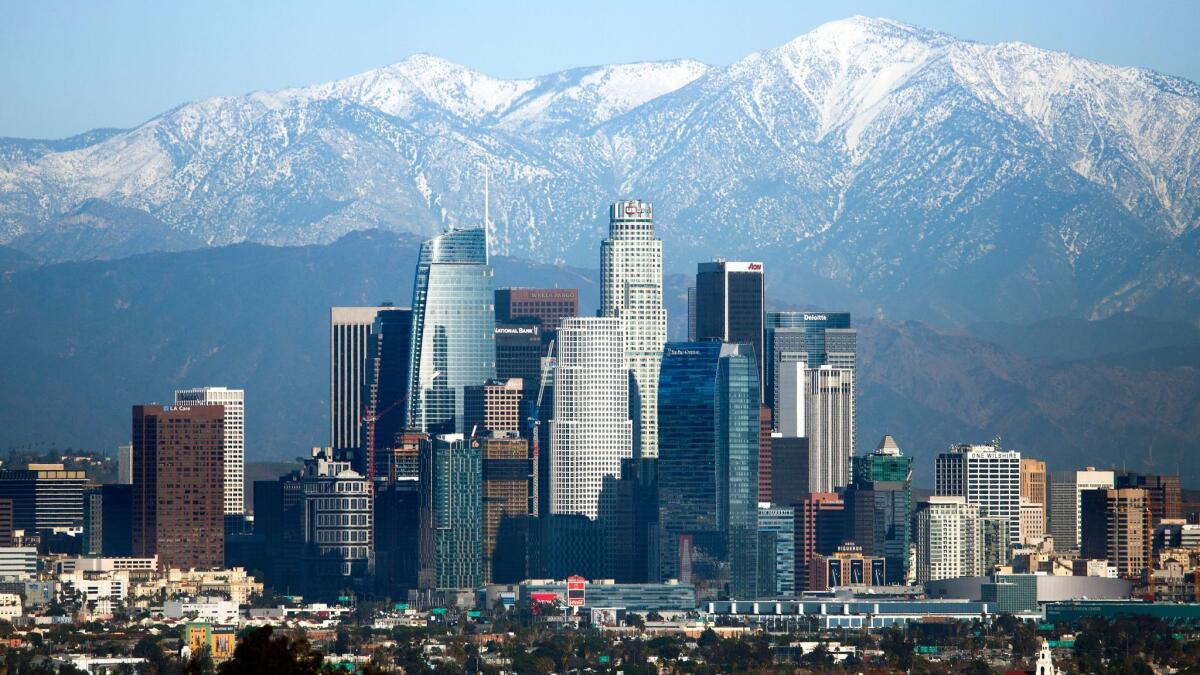Editorial: Neither snow nor rain nor sleet nor hail can end California’s drought? Really?

OK, so letâs get this straight: California is soaked, Los Angeles had its wettest December in six years, the new yearâs first storm is making way for a second with a third due over the weekend, roads are closed due to flooding, ski resorts at Mammoth in the Eastern Sierra are expecting 20 feet of snow, skiers are being warned of avalanche conditions, reservoirs are refilling â and yet we still canât put our drought and all those emergency conservation efforts in the rearview mirror?
No, we canât. Despite all that December rain and snow, the yearâs first official measurement found that the water in the crucial Sierra snowpack hovers at around two-thirds of the historical average for early January.
Itâs only natural to think of a drought in its most literal sense: Too little water falling from the sky. Or rather, the same number of storms producing the same amount of water but in the wrong places â Texas, for example, instead of California.
That has been the story over nearly a decade of drought, broken only by a wet winter in 2010. Last yearâs El NiĂąo brought rain and snow to the northern part of the state but was a bust in the south.
Even with the return of rain and snow, California has to rethink its water use.
As a practical matter, though, the stateâs water situation must be measured in terms of geography and temperature as well as precipitation. Winter storms move in from the Pacific and drop rain until they hit the Sierra Nevada and move up the mountains. The higher they get in elevation, the colder the air gets, dropping up to five degrees for every 1,000 feet. The climate on mountain peaks is comparable to the Arctic. Storms that push high enough up the mountains will drop their water as snow.
Thatâs important, because the Sierra snowpack is by far the stateâs largest âreservoir.â Itâs generally at its biggest by the end of March. Then, at least through much of the 20th century and into the 21st â it steadily releases its water into streams and rivers with rising spring and summer temperatures, exactly when it is needed to irrigate crops and quench the thirst of urban dwellers.
But if the storms arenât cold enough to begin with, or if the mountain air with which they collide is too warm, the water may come down as rain instead of snow. Or if spring and summer come too early, the snowpack will melt too fast. In either case that means too much water coming all at once, and at the wrong time. Instead of a steady flow to fields, homes and reservoirs, we will have floods.
Scientists are cautious about attributing any particular seasonâs apparent anomalies to global climate change, but they also note an unmistakable increase in temperature in recent years. Plant and animal life once at home in the foothills are retreating up the mountain slopes along with the cooler temperatures. It may still be Arctic-like at the summit, but the Arctic itself is warmer. Just as the icepack at the top of the world is endangered, so is the Sierra snowpack â even if Californiaâs winter storm pattern is back to stay.
So should we build more dams to replace the shrinking snowpack? New dams up and down the state would yield only a tiny fraction of the water held in Sierra snow, and besides, most viable sites already have been dammed. One or two dams might help recharge the stateâs depleted groundwater.
The Sierra Nevada rises higher, and therefore colder, in the southern part of the range, where the snowpack could survive. That could make the water that flows northward from that part of the Sierra through the San Joaquin River and its tributaries more important than ever for migrating fish and the health of the fragile Sacramento-San Joaquin River Delta, which supplies much of the stateâs irrigation and drinking water. But the San Joaquin currently runs dry much of the year due to excessive diversions to upstream dams. A legal settlement to restore it is under threat not just by the drought but by interests with designs on the water before it makes its way to the Delta.
Itâs complicated. Even with the return of rain and snow, California has to rethink its water use. The drought may finally be skulking away. But our water challenges are here to stay.
Follow the Opinion section on Twitter @latimesopinion and Facebook
MORE FROM OPINION
Seeing the devastation of climate change in the ruins of Aleppo
2017 is shaping up to be a banner year for anti-LGBT discrimination
Campuses are breaking apart into âsafe spacesâ
When it comes to challenging Trump on Russia hacking, Democrats should lead from behind
More to Read
A cure for the common opinion
Get thought-provoking perspectives with our weekly newsletter.
You may occasionally receive promotional content from the Los Angeles Times.










